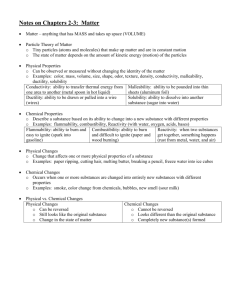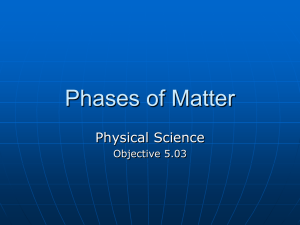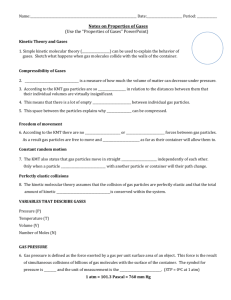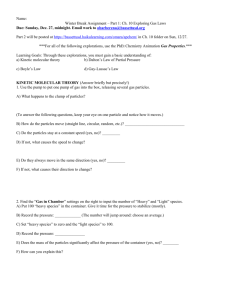What is the transfer (input) of thermal (heat) energy in this system
advertisement
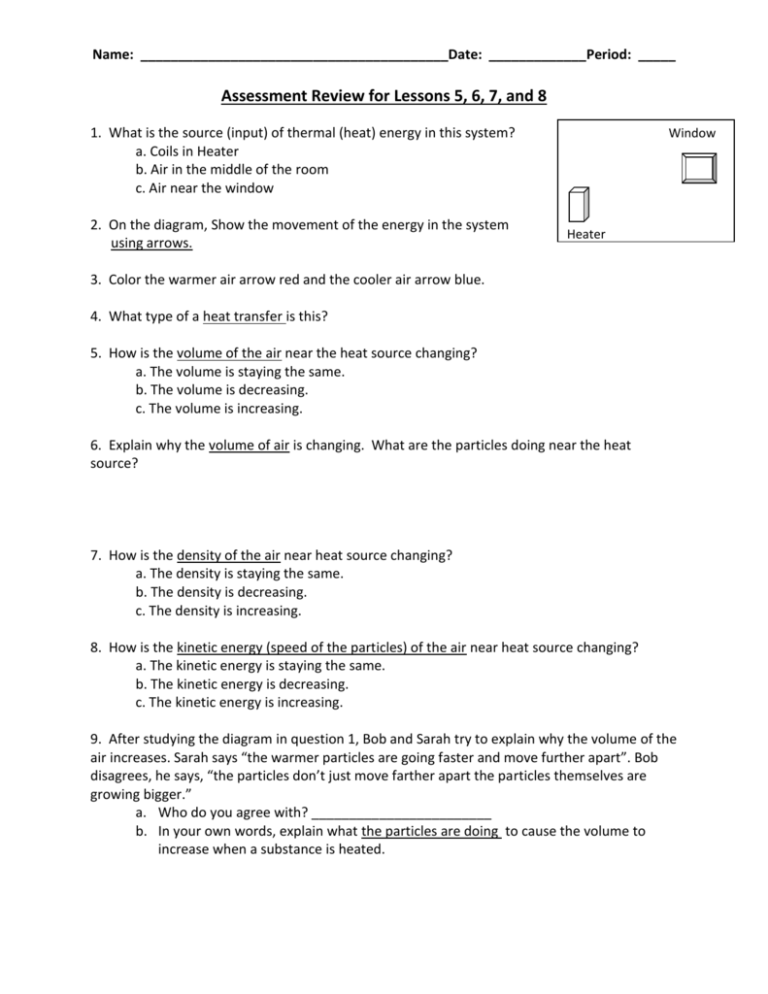
Name: _________________________________________Date: _____________Period: _____ Assessment Review for Lessons 5, 6, 7, and 8 1. What is the source (input) of thermal (heat) energy in this system? a. Coils in Heater b. Air in the middle of the room c. Air near the window 2. On the diagram, Show the movement of the energy in the system using arrows. Wi nd ow Window Heater 3. Color the warmer air arrow red and the cooler air arrow blue. 4. What type of a heat transfer is this? 5. How is the volume of the air near the heat source changing? a. The volume is staying the same. b. The volume is decreasing. c. The volume is increasing. 6. Explain why the volume of air is changing. What are the particles doing near the heat source? 7. How is the density of the air near heat source changing? a. The density is staying the same. b. The density is decreasing. c. The density is increasing. 8. How is the kinetic energy (speed of the particles) of the air near heat source changing? a. The kinetic energy is staying the same. b. The kinetic energy is decreasing. c. The kinetic energy is increasing. 9. After studying the diagram in question 1, Bob and Sarah try to explain why the volume of the air increases. Sarah says “the warmer particles are going faster and move further apart”. Bob disagrees, he says, “the particles don’t just move farther apart the particles themselves are growing bigger.” a. Who do you agree with? ________________________ b. In your own words, explain what the particles are doing to cause the volume to increase when a substance is heated. 10. If you have a 50 gram metal ball at 30 degrees Celsius and you cool the metal ball to 2 degrees Celsius, what happens to the mass (the number of particles) in the ball? a. The mass stays the same. b. The mass decreases. c. The mass increases. 11. Explain why your answer is correct. Use the heat curve to answer the following questions: 12. 13. 14. 15. Approximately, what is the boiling point of the substance? ________ Approximately, what is the melting point of the substance? ________ About how long does it take until the substance completely melted? _________________ At 40 degrees C, what phase(s) of matter is the substance? _________________ Identify the following statements as a solid, liquid or gas: 16. Lowest amount of kinetic energy (particle movement). _______________ 17. Definite volume and definite shape (shape and volume stay the same). ________________ 18. Particles are farthest apart and move independently of each other. __________________ 19. Particles have a definite volume and take the shape of their container. _________________ 20. Directions: Fill in the following chart. Phase Change Beginning Ending Phase Phase Melting Freezing Boiling/Evaporation Condensing Liquid Solid Input or Output Change of Kinetic of Energy for Energy Phase Change to (particle speed) Happen? Increases Output Liquid Liquid Decreases 21. Define the following words: Freezing:_____________________________________________________________________ ______________________________________________________________________________ Melting:______________________________________________________________________ ______________________________________________________________________________ Boiling:_______________________________________________________________________ ______________________________________________________________________________ Condensing:___________________________________________________________________ ______________________________________________________________________________ Boiling/evaporating (vaporization): ______________________________________________________________________________ ______________________________________________________________________________ 22. Name and describe each of the three types of heat transfers: Heat Transfer #1: ________________________ Description: __________________________________________________________________________ ______________________________________________________________________________ ______________________________________________________________________________ Heat Transfer #2: ________________________ Description: __________________________________________________________________________ ______________________________________________________________________________ ______________________________________________________________________________ Heat Transfer #3: ________________________ Description: __________________________________________________________________________ ______________________________________________________________________________ ______________________________________________________________________________ 23. How would 10 particles of a solid, liquid, and gas behave when placed in a cylinder. In each cylinder, draw the 10 particles the way that you think they would look. Solid Liquid Gas Explanation of why the particles look like this. (Mention their kinetic energy and density). Explanation of why the particles look like this. (Mention their kinetic energy and density). Explanation of why the particles look like this. (Mention their kinetic energy and density). For questions 24 – 26 use your notes and review to help you. 24. What does temperature measure? ______________________________________________________________________________ ______________________________________________________________________________ 25. Describe what is happening to particles of a material when heat energy is transferred to the material and the temperature increases. ______________________________________________________________________________ ______________________________________________________________________________ 26. What happens to the temperature of a material when the material is undergoing a change of phase (for example, from a solid to liquid)? ______________________________________________________________________________ ______________________________________________________________________________ 27. Container A contains air (a gas). You transfer all the particles from container A to container B. Draw how the particles will be arranged. (Still a gas) when they are in container B. Explain why your particle drawing makes sense. Will there be more, less or the same number of particles in Container A Container B Container B after you transfer the particles? Explain. 28. After lunch one day, your friend brings in to science class, a snowball that has a mass of 18 grams. You place the snowball in an empty plastic container and seal the container. a) What will be the mass of the snowball when it melts into a liquid? ___________________ b) Explain why your answer is correct. ______________________________________________________________________________ ______________________________________________________________________________ 29. Identify each picture below as an example of heat transfer: Radiation, Convection or Conduction: What is going on inside the pot of liquid? ______________________________ __________________________ _______________________________


